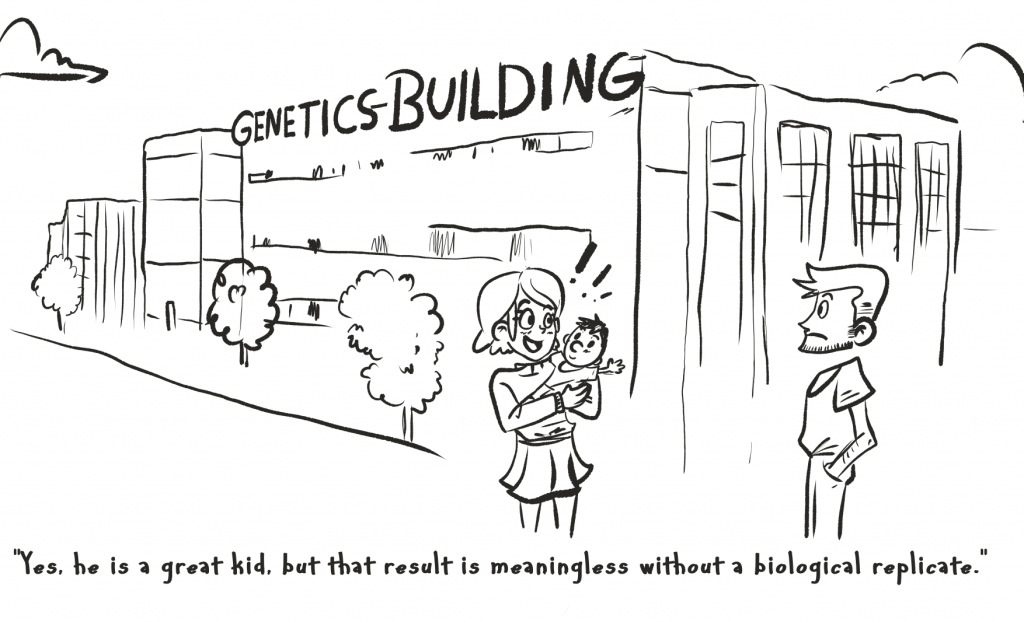 Considering my career as a whole, I have had a major role in three hugely creative experiments. It might be instructive to examine the features common to the three. They were all carried out when I was relatively young and my title was assistant professor. They all occurred when I had relatively little funding. Perhaps surprising to you, but gratifying to me, they all remained unpublished. They all involved a close partnership with the same collaborator. And they all resulted in boys.
Considering my career as a whole, I have had a major role in three hugely creative experiments. It might be instructive to examine the features common to the three. They were all carried out when I was relatively young and my title was assistant professor. They all occurred when I had relatively little funding. Perhaps surprising to you, but gratifying to me, they all remained unpublished. They all involved a close partnership with the same collaborator. And they all resulted in boys.
You might think that what follows will be my take on the wonders of developmental biology, as I watched my sons grow into fine young men, now in their twenties. But I’ll use this jumping off point to dive into less safe waters and consider the choices that men and women in science often face. For despite progress that has been made, the choices are still inequitable.
Ecklund and Lincoln (2011) surveyed more than 2,500 scientists, including grad students, postdocs, and faculty. Among the faculty, almost twice as many women (45.4%) as men (24.5%) had fewer children than they desired. Among graduate students, nearly four times as many women (28.5%) as men (7.2%) worry that a science career will keep them from having a family. Those grad students or postdocs who feel that a science career will keep them from having as many children as they’d like to are more apt to desire a career outside of science. And the total fraction of grad students, both male and female alike, who contemplate leaving science – about one quarter – strikes me as worrisomely high and highly worrisome.
Some young people will always be leaving our profession because they simply may not be up for its demands. But if they love science and they’re good at it, then their loss is tragic. We lose the discoveries they would have made; we lose the substantial investment that society, largely through Federal grants, has made in them; we lose the leadership they would have provided to the next generation. Although I have no evidence to back me up, based on the career expectations for men and women that persist in our culture, my guess is that the women who drop out are, on average, of higher caliber than the men.

What can universities and funding agencies do to make a career in science more appealing? Obviously, affordable and available on-site day care facilities would be a good start. We could allow those on fellowships who become parents to dial their effort down and up as needed and extend the duration of their fellowship. We could make tenure clocks more flexible than a common policy of adding an extra year per child – some new parents might want two extra years before tenure review to spend time with a newborn. But my suspicion is that these kind of accommodations alone won’t be enough to convince many young people who want children to stay in science.
Consider what some countries have done to encourage an increase in their low birthrates: Australia and Singapore offer significant maternity payments, with the latter country spending $1.3 billion to encourage its citizens to have more children; France offers generous tax deductions, subsidies, and funding for housing that equals nearly 4% of its GDP; Sweden allows a parent who stops work after the birth of a child to claim 80% of the parent’s previous net wages. Germany spends an astounding $265 billion a year on family subsidies (for comparison: the NIH budget is about $32 billion a year).
If we’re to ensure that a career in science is not a prescription for childlessness, then maybe the scientific community, too, should put real money into the effort. Why not give a grad student or postdoc – whether a woman or a man – who has a child an additional year of support on a training grant or fellowship? Why not give an NIH grant-holder who has a child an additional year of grant funding? This extra year could help with the cost of parental leave as well as the inevitable loss of productivity, along with sleep, upon the new parent’s returning to work. The effect would be that someone with a four-year grant at $200,000 direct costs/year who has two children during the funding period would now have a six-year grant and $400,000 additional in direct costs.
A fundamental issue that makes science a tough job – contributing to concerns about being able to have children – is that the amount of Federal funding needed for the enterprise has not kept up. Yet the additional funds required for the family-friendly policy I propose – which likely would not be small sums – are also not likely to be added to some future NIH budget. That means they would have to come at the expense of other research priorities.
Should the NIH award fewer training slots and fewer research grants to ensure that those it does award accommodate childbearing? Are there some initiatives that we should forego to enable funded extensions for new parents? These are interesting questions.
There must be lots of other ideas to make science more family friendly. Write to me with your suggestions (my last name at uw.edu; subject line: Family) and we’ll put them up here.
CITATION:
Elaine Howard Ecklund and Anne E. Lincoln. (2011). Scientists want more children. PLOS ONE 6(8): e22590. DOI:10.1371/journal.pone.0022590












